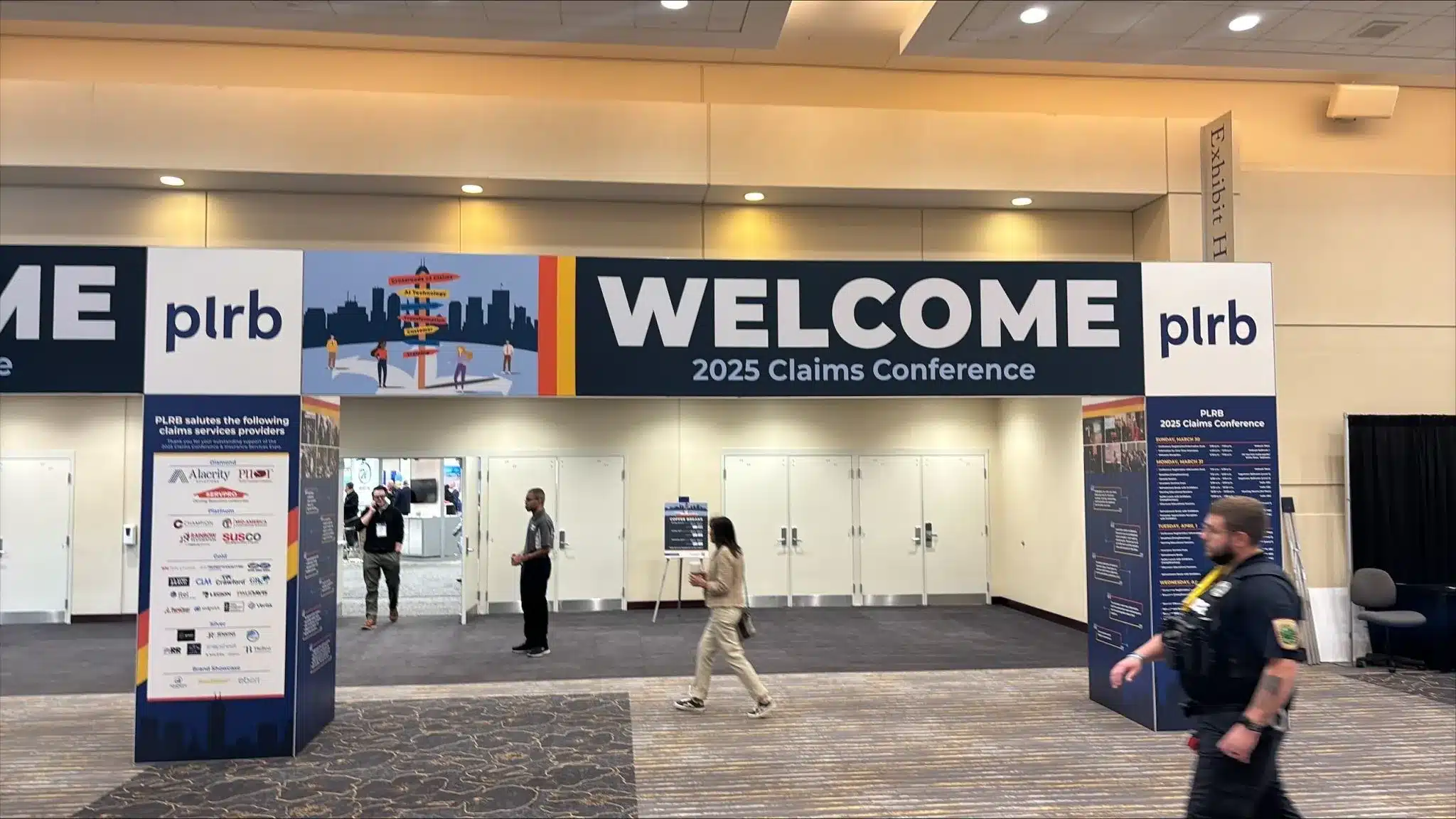The 2025 PLRB Claims Conference, held in Indianapolis, was a pivotal event for anyone working in property and casualty insurance. From March 30th to April 2nd, it was all about adjusters, lawyers, and tech innovators… wrestling with the same old question: How do we use the power of technology in insurance without losing the human touch? The conference had an answer to this question in the form of 100+ educational sessions, dynamic keynote speakers, and an exhibit hall featuring the latest Insurtech solutions. But what stuck with me was the recurring theme—how to advance technology while prioritizing human-centric practices.
Team Damco stood out by showcasing our strategic AI roadmap that has delivered measurable improvements in claims efficiency. The event provided us with the opportunity to connect with existing and potential clients, reinforcing Damco’s impact in creating operational excellence across the entire claim lifecycle.

In this piece, I have covered the top insights from the 2025 PLRB Claims Conference. The article offers claims professionals, lawyers, and industry leaders a helpful overview of current trends and practical strategies.
Table of Contents
1. The Ascendancy of AI and Technology in Claims Processing
I. AI-Powered Solutions Are Redefining Efficiency and Accuracy
Here’s one thing that kept coming up at the conference. How AI is quietly transforming claims workflows—without forcing a choice between speed and accuracy. Ramón Lopez, President of Claim Assist Solutions, emphasized how machine learning now handles tasks like fraud detection and damage assessments faster than ever, and with precision. For instance, AI image recognition tools analyze property damage photos with close to 98% accuracy, reducing the reliance on manual inspections.
In another session, David S. Milton, Founder and CEO of TelaClaims, showcased how proprietary AI platforms are changing catastrophic loss management. Their teams use an advanced claims management system ‘Merge’ to process satellite imagery and weather data in real time to prioritize high-risk claims during natural disasters; this slashes response times by up to 40%.
II. Insurtech Innovations in the Exhibit Hall
This was a major highlight of this event. Snapsheet showcased an automated claims management software integrates custom fields for property and liability claims, pulling all data in one place.
Likewise, Floatbot.AI introduced LISA, a virtual assistant that handles the First Notice of Loss (FNOL) via calls, texts, and emails. Its AI scheduler, ADDI, automates inspection appointments. One adjuster mentioned the tool saves their team 40+ hours every month while reducing claims leakage by up to 45%.
As I walked through the hall, one thing was quite apparent: the industry isn’t just adopting new tools—it’s building a fully digital ecosystem.
III. Ethical and Operational Challenges
Not everything at the conference was a glowing endorsement of AI. A classic example of this would be the session “How I Learned to Love HAL 9000”. It dug into the ethical risks of relying too much on automation. Cassandra Hand-Gallegos (CCMS & Associates) advocated for “human-in-the-loop” systems where technology assists human adjusters instead of replacing them.
Then several discussions focused on minimizing AI bias. Vendors stressed the need for transparent model training and ongoing audits to ensure fairness and accountability.
2. Legal and Regulatory Updates Shaping Claims Practices
I. State-Specific Case Law and Policy Interpretations
Legal sessions provided some eye-opening updates on recent rulings shaping claims practices. Take Texas, where courts recently clarified that if multiple people witness a car crash, insurers don’t have to pay each bystander separately for emotional distress. They all fall under the same “per person” coverage limit. This decision tightens payout rules for accidents involving multiple claimants.
Then there’s Kansas doubling down on construction defects, ruling they do not qualify as an “occurrence” under commercial general liability (CGL) policies. The decision will clearly limit the liability coverage for contractors.
I also witnessed a standout session featuring David Heemann and Jennifer Kalvestran (Tyson & Mendes). It was interesting, as they dissected strategies to address shady contractor estimates. The duo highlighted several North Carolina cases where undisclosed relationships between appraisal umpires and policyholders led to rejected payouts. Their advice is to vet appraisal panels rigorously to avoid conflicts of interest.
II. Subrogation and Bad Faith Litigation Trends
David Brisco and Paul Ferland (Cozen O’Connor) discussed subrogation—the process where insurers recover costs from third parties responsible for damages. They stressed that adjusters and legal teams need to team up early to lock down evidence like photos, repair invoices, or witness statements. Without that collaboration, strong cases can fizzle fast.
Another session zeroed in on bad faith litigation, where insurers face lawsuits for unfair claim handling. Lauren Berenbaum explained how delaying disputes over contractor bills during post-repair negotiations (called “post-work supplementals”) can expose insurers to liability. She advised addressing billing issues quickly and communicating with policyholders proactively.
3. Fraud Detection and Evolving Claims Management Strategies
I. Combatting Sophisticated Fraud Schemes
The conference included sessions like “Don’t Get Nailed by Roofing Fraudsters” that explored new fraud tactics. Take roofing fraud: Dan Parker (J.S. Held) explained how contractors misuse hailstorm events by creating fake damage reports using old photos. The fix? AI tools like Tractable now compare historical satellite images with current claims. This cuts fraudulent insurance payouts by up to 25%.
II. Water Damage and Catastrophic Loss Mitigation
Water damage claims were another major focus. Michelle Feduccia (J.S. Held) shared how IoT (Internet of Things) solutions are changing the game. Smart home sensors, such as water flow monitors and automatic shut-off valves, now alert insurers and homeowners to pipe bursts or leaks within minutes. This real-time detection helps minimize secondary damage (e.g., mold growth or structural harm) by enabling swift repairs. One insurer explained how these gadgets cut average repair costs per claim.
But what about large-scale disasters, like floods? Tim Gillihan (J.S. Held) introduced parametric insurance—a proactive model that uses objective data (like rainfall levels or river height) to trigger instant payouts. Instead of waiting for adjusters to inspect damage, these policies automatically release funds when predefined thresholds (e.g., 10 inches of rain in 24 hours) are met. This approach speeds up financial aid for policyholders, such as families displaced by floods.
The big takeaway? Whether it’s a dripping pipe or a catastrophic storm, tech is helping insurers act faster and policyholders recover sooner. Here’s one of my recent articles on underwriting where I’ve talked about the growing importance of AI automation in insurance underwriting and the benefits that tag along with it.
4. The Human Element: Culture, Leadership, and Policyholder Engagement
I. Cultivating Resilience and Empathy in Claims Teams
One standout moment came from keynote speaker Renee Bruns, a disability advocate who’s traveled to 140 countries—in a wheelchair. Her message? Adaptability isn’t just nice—it’s non-negotiable. She urged teams to ditch rigid rules and focus on what matters: real, human connections.
The conference also highlighted the significance of workplace culture. Robin Roberson (Agentech) shared an example where Mid-America Catastrophe Services team paused work to celebrate a colleague’s birthday. Sounds simple, but it’s these small gestures that play a role in improving loyalty and boosting morale.
Leadership sessions echoed this theme. Rod Patterson’s talk “5 Deadly Venoms of Leadership”, cautioned against micromanagement. His advice? Hire good people, then trust them. Teams thrive when they’re empowered to make decisions, not just follow orders.
Summing Up: Balancing Innovation with Humanity
All-in-all, it was a great event to be a part of. In my opinion, the 2025 PLRB Claims Conference has highlighted a clear path for the insurance industry, which is, embracing technology while keeping people at the core. AI and Insurtech tools certainly boost efficiency, but sessions stressed they should support—not replace—human judgment. Success will belong to those who harmonize technology with the irreplaceable value of human connection.





